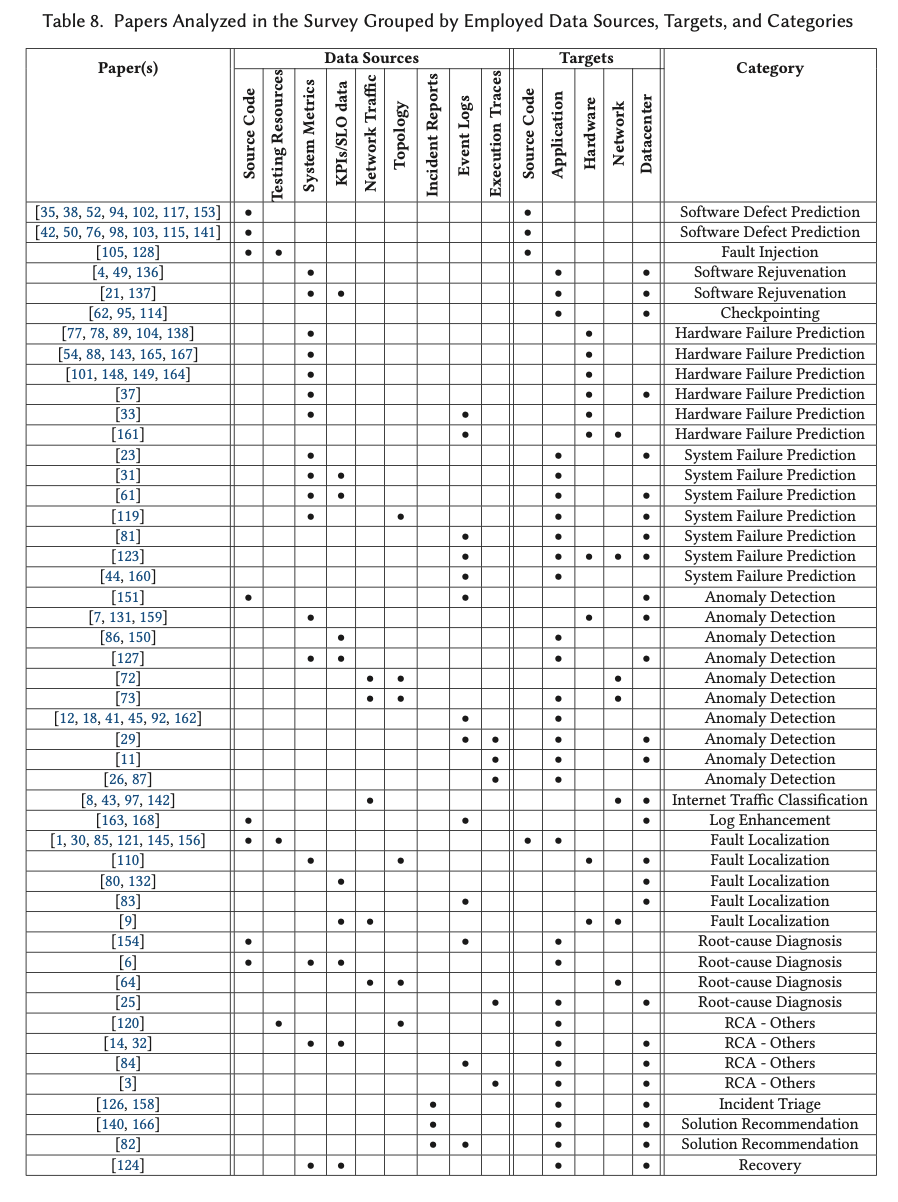論文解析 -- A Survey of AIOps Methods for Failure Management
此篇Survey是A Systematic Mapping Study in AIOps的後續研究
對於AIOPS中佔比較高的Failure Management進行進一步的研究
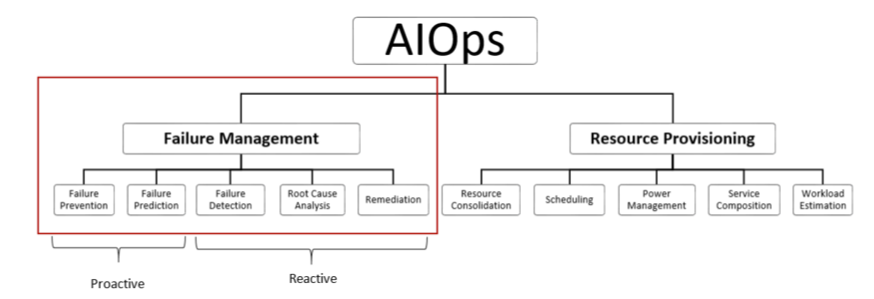
Compared to traditional approaches, AIOps is:
• fast, because it reacts independently and automatically to real-time problems, without re- quiring long manual debugging and analysis sessions;
• efficient, because it takes advantage of the monitoring infrastructure holistically, removing data silos and improving issue visibility. By forecasting workload requirements and modeling request patterns, AIOps improves resource utilization, identifies performance bottlenecks, and reduces wastages. By relieving IT operators from investigation and repair burdens, AIOps enables in-house personnel to concentrate more effort on other tasks;
• effective, because it allocates computer resources proactively and can offer a large set of actionable insights for root-cause diagnosis, failure prevention, fault localization, recovery, and other O&M activities.
The term AIOps was originally coined by Gartner in 2017 [74], for which 「AIOps platforms utilize big data, modern Machine Learning and other advanced analytics technolo- gies to directly and indirectly enhance IT operations.」
All these definitions share two common objectives: (1) enhance IT services for customers and (2) provide full visibility and understanding into the operational state of IT systems.
The most cited AIOps problems are anomaly detection [36, 75, 107, 129], root-cause analysis [17, 75, 96, 116], resource provisioning [36, 107, 116, 129], failure remediation [17, 96, 116], and failure prediction and prevention [17, 75, 79].
AIOPS相關綜述,
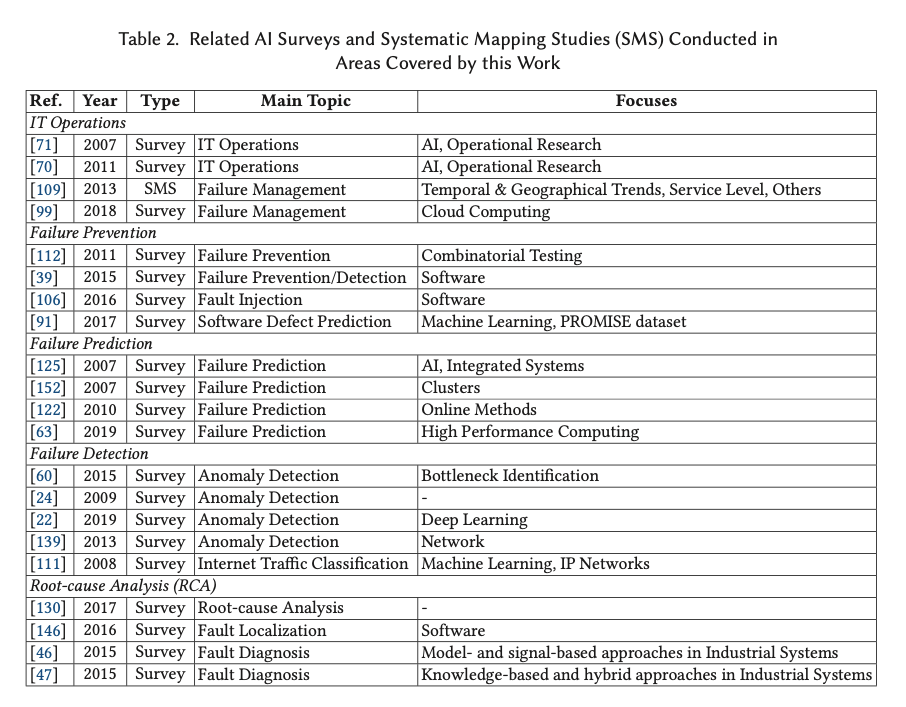
論文總結出,對於演演算法評價標準度量的各種方法,
Mean-squared Error (MSE) 均方誤差,最直觀

後續的度量方法基於這張表,

accuracy,準確性。所有Pre中,判斷正確的比例

pricision,recall,精確度,召回率。判陽中,判斷準確比例;所有陽中,被判斷出的比例

false-positive rate (FPR, also called false alarm date) 假陽率。所有陰中,被誤判成陽的比例

true-negative rate (TNR, or specificity) 真陰率。所有陰中,被正確判定為陰的比例

單純的看P, R都有偏面,所以綜合
F1-score (or F- score/F-measure)

這裡思路很清晰,FM分為主動avoidence和被動tolerance
主動avoidence,意味著在failure未發生前,分為predicting和preventive
被動tolerance,意味著在failure發生後,detection,RCA,remediation
當前主要的研究方向偏向被動,偏向發現問題分析問題,解決問題和閉環的研究比較少
Failure Management (FM) is the study of techniques deployed to minimize the appearance and impact of failures.
We differentiate between proactive (failure avoidance) and reactive (failure tolerance) approaches
Failure avoidance comprises any approach aiming to address failures in anticipation of their occurrence, either by predicting the appearance of errors based on the system state or by taking preventive actions to minimize their future incidence.
Failure avoidance is divided into failure prevention (Section 4.1) and online failure prediction (Section 4.2).
Failure tolerance techniques, however, deal with errors after their appearance to assist humans and improve mean-time-to-recovery (MTTR).
Failure tolerance includes failure detection (Section 4.3), root-cause analysis (Section 4.4), and remediation (Section 4.5).
The FM area with the highest number of contributions is failure detection (226, 33.7%), followed by root-cause analysis (179, 26.7%) and online failure prediction (177, 26.4%).
Failure prevention
目的是降低失敗發生的概率和影響,分為靜態(原始碼分析)和動態
Failure prevention mechanisms, tend to minimize the occurrence and impact of failures, by analyzing the configuration of the system, both in static aspects (like the source code) and dynamic aspects (e.g., the availability of computing resources in physical hosts).

Software Defect Prediction.
計算程式碼存在bug的概率
SDP determines the probability of running into a software bug (or defect) within a functional unit of code (i.e., a function, a class, a file, or a module).
傳統的方法,基於code metrics來構建defect predictor。
所以前期的研究主要在於用哪些metrics,基本是一些從原始碼手工構建的features,比如基於模組的圖複雜度,讀複雜度,基於OO的CK metrics,模組間的耦合度,甚至LOC
A traditional method to identify fault-prone(易於出錯) software consists in constructing defect predictors from code metrics.
Code metrics are handcrafted features obtained directly from source code, which potentially have the power to predict fault proneness in software.
Over the last decades, different groups of code metrics have been proposed:
the original module-level metrics, designed during the 1970s for procedural languages, describing graph complexity (McCabe metrics [90]) and reading complexity (Halstead metrics [53]);
Chidamber and Kemerer [28] later defined a suite of metrics for object-oriented software on a class level, usually referred to as 「CK metrics」 (from the authors’ initials);
Briand et al. [16] have introduced coupling metrics as a measure of interconnection between software modules;
finally, the Lines-of-Code (LOC) metric is widely adopted across the research community.
研究方向後續又轉換到,使用怎樣的方法來構建defect-prone,defect-free的分類器
有基於SVM加高斯核的研究,有基於BN貝葉斯網路的研究
Attention is moved from the choice of metrics to the choice of learners: by applying decision trees and Naïve Bayes models, software modules are classified as defect-prone or defect-free.
研究提出,原始碼的變化也是軟體faults的一個主要原因
所以有學者提出,要分成product measures和process measures,來量化the change history of a software project
A potential indication of the presence of software faults may also come from the change history of source code.
In particular, the code age and the number of previous defects can be indicative to estimate the presence of new bugs.
Graves et al. [52] divide software quality predictors into product measures (like code metrics) and process measures, which quantitatively describe the change history of a software project, advocating for the latter category (product measures are considered inconclusive from a correlation analysis).
In addition to introducing the benchmark SDP dataset AEEEM, D’Ambros et al. [35] compute several change-related metrics, such as the number of revisions, refactorings, and bug fixes per file, which are correlated with the number of future defects.
學者提出,傳統的code metrics過於簡單和依賴人工,提出使用原始碼的AST作為新的metrics。
A critique of traditional code metrics is that they are too handcrafted and simplistic. An alternative is to directly parse the source code using Abstract Syntax Trees (AST).
In their work, after parsing the code with ASTs, a Deep Belief Network (DBN) is trained to learn semantic features in an unsupervised fashion via stochastic first-order optimization.
比較有意思的是提出用CNN來對於AST進行抽象,學習出encoder,可以將AST轉換成中間表示,再結合傳統的code metrics進行整體的預測
Li et al. [76] explore Convolutional Neural Networks (CNN) for SDP.
During the parsing step, a subset of AST nodes corresponding to different types of semantic operations is extracted.
These tokens are mapped to numerical features using embeddings and fed into a 1D convolutional architecture,
which is used to learn intermediate representations of the input code, and later integrated with handcrafted features for the final prediction.
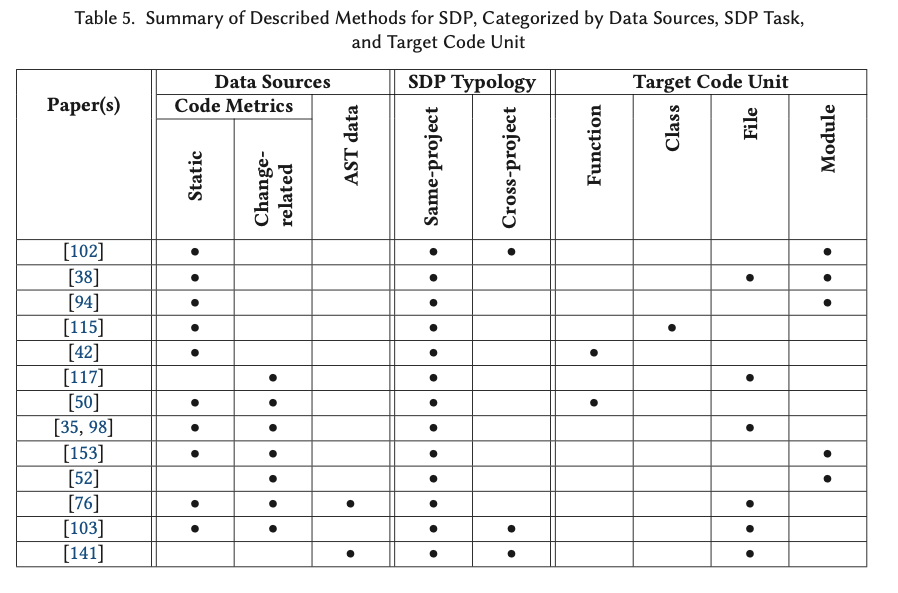
Fault Injection.
故意引入faults,來評估系統的fault tolerance水平
Fault injection is the deliberate introduction of faults into a target working system [5] to evaluate the level of fault tolerance reached.
Important definitions in fault injection are the set of injected faults or faultload (F);
the set of activations of faults in the system (A);
the set (R) of readouts from the system and the set (M) of measured values.
F and A model the injection procedure from the input, R and M from the output [5].
這種技術在分散式系統上用處更加明顯,比如Netflix的Chaos Monkey
In a distributed computing environment, fault injection can also be applied at the cluster or datacenter scale,
for example, to randomly terminate operations at the instance level and stress test the resiliency of the distributed service under investigation.
This is the case with software tools such as Chaos Monkey and Kong by Netflix [13] or Facebook’s Project Storm [69].
Finally, fault injection techniques can be applied at the network level based on principles that are similar to the hardware and software level previously cited.
Software Aging and Rejuvenation.
老化,隨著程式執行,逐漸累積的錯誤,比如記憶體洩露,資料碎片,鎖未釋放等
研究基本就是通過,擬合,迴歸的方法去預測系統風險
Software aging describes the process of accumulation of errors during the execution of a program that eventually results in terminal failures, such as hangs, crashes, or heavy performance degradations [49].
Known causes of software aging include memory leaks and bloats, unreleased file locks, data fragmentation, and numerical error accumulation [21].
Several Machine Learning techniques have been applied to predict the exhaustion of resources preemptively.
Garg et al. [49] estimate time-to-exhaustion of system resources, such as free memory, file and process table sizes, and used swap space, using instrumentation tools available under the UNIX operating system.
年輕化,清除內部的狀態,比如GC
Software aging can be contrasted with software rejuvenation [57], a corrective measure where the execution of a piece of software is temporarily suspended to clean its internal state.
Software rejuvenation can be performed at the software and OS level. Common cleaning operations include garbage collection, flushing kernel tables, reinitializing internal data structures [136].
To this end, authors distinguish between periodic (or synchronous) and prediction-based (or asynchronous) rejuvenation policies, where the latter requires a prediction model for future software failures.
Checkpointing.
用演演算法選擇不同的CP策略和CP排程問題
A concept linked to software rejuvenation is checkpointing, i.e., the continuous and preemptive process of saving the system state before the occurrence of a failure.
Similar to software rejuvenation, checkpointing tolerates failures by occasionally interrupting the execution of a program to take precautionary actions.
Different from software rejuvenation, during checkpointing the interruption period is used to save the internal state of the system to persistent storage.
In case a fatal failure occurs, the created checkpoint file can be used to resume the program and reduce failure overhead.
AI is used to model a faulty execution workload under different checkpointing strategies and select the most suitable strategy according to different objectives.
Again, checkpointing can be static or dynamic depending on the scheduling of checkpoints.
Online Failure Prediction
A prediction of failures on-the-fly allows one to be aware of future failures but also to know in advance the remaining useful to recovery, vital to timely deploy recovery and failover mechanisms.

Hardware Failure Prediction.
這個領域中,大部分的研究集中在硬碟的Failure Prediction,94年硬碟廠商就提出SMART技術,在實際的研究中,發現SMART features充分非必要,大量的硬碟fail前不一定有明顯的SMART error signal
在後續的研究中,部分方向是如何補充SMART features,部分是如何基於SMART,使用不同的學習和分類方法。
In large-scale computing infrastructures, hardware reliability represents one of the most relevant practices to achieve service availability goals in distributed services.
Hard drives are the most replaced components inside large cloud computing systems (78%) and one of the dominant reasons for server failure [138].
Machines with a higher number of disks are also more prone to experience additional faults in a fixed time period.
This fact has led hard-drive manufacturers to adopt common self-monitoring technologies (such as Self-monitoring Analysis and Reporting Technology (SMART)) in their storage products since 1994 [100].
However, some SMART features were shown to correlate well with a higher failure rate.
However, SMART metrics were also shown to be likely insufficient for single-disk predictions, as the majority of failed drives did not manifest any SMART error signal before faults.
一個不同的思路將SMART資料作為事件序列,強調時間資訊的重要性,這樣的差異是可以使用隱馬爾可夫,半馬爾科夫來進行建模
Different from previous works [54, 101], Zhao et al. [164] treat SMART data as a time series, arguing for the importance of temporal information.
Their approach employs Hidden Markov and Semi-Markov Models (HMM/HSMM) to estimate the sequence of likely events from the disk metric observations, which are obtained from a dataset of approximately 300 disks .
基於滑動時間視窗的方法
Murray et al. [101] test the applicability of several Machine Learning methods using a sliding window approach, where the last n samples constitute the observation for predicting an imminent(迫在眉睫) failure.
基於RNN的方法,這個是之前基於馬爾科夫方法的延續,
The same SMART dataset is used by Xu et al. in a paper [149] that introduces Recurrent Neural Networks (RNN) to hard drive failure prediction.
Similar to Reference [164], the method can analyze sequences directly and to model the long-term relationships takes advantage of the temporal dimension of the problem.
|Differently from previous approaches that apply binary classification, the model is trained to predict the health status of the disk, providing additional information on the remaining useful life of disks.
上面的方法都是離線訓練,這裡提出的方法可以動態的根據新的資料更新模型
To this end, Xiao et al. [148] propose the use of Online Random Forests, a model able to evolve and behave adaptively to the change in the data distribution via online labeling.
除了硬碟,也有基於其他裝置的相關研究
其中對於用RNN預估系統主件剩餘的使用週期的研究可以關注
Although most of the scientific interest is concentrated around disk failures, a minor group of contributions, focusing on failure prediction for other components, is present. Ma et al. [88] elevate the discussion on storage reliability to the level of RAID groups.
Costa et al. [33] investigate the occurrence of main-memory errors for HPC applications. They propose and evaluate methods for temporal and spatial correlation among memory failures.
Zhang et al. [161] deal with the problems of failure prediction and diagnosis in network switches.
Their method, based on system log history, proposes to extract templates from logs and correlate them with faulty behavior.
Zheng et al. [165] propose a method based on RNN to estimate the Remaining Useful Life of system components.
They argue that the temporal nature of sensor data justifies the use of long short-term memory (LSTM)-based RNNs, due to their ability to model long term-dependencies.
System Failure Prediction.
System失敗是在軟體層面的,基於log,metrices等作為輸入
Instead of investigating the occurrence of physical component failures, future system availability can also be estimated through symptomatic evidence and dependency modeling assumptions at the software level.
Past approaches for system failure prediction are mostly based on the observation of logs, which constitute the most frequent data source, KPIs and hardware metrics, which are typically used in shorter prediction windows and are more frequently associated with the failure detection problem as well.
利用貝葉斯網路建模各種observed variables的關聯性,從而detect SLO violations
Cohen et al. [31] investigate an approach based on Tree-augmented Bayesian Networks (TANs) to associate observed variables with abstract service states, forecast and detect SLO violations and failures in three-tiered Web services. The system is based on the observation of system metrics, such CPU time, disk reads, swap space, and KPI-related measures, like the number of served requests, all interdependently modeled (in addition to the dependent variable, the predicted state).
基於錯誤紀錄檔的事件序列來線上預測failures,這個有點意思
Salfner et al. [123] train HSMM for online prediction of failures in event sequences collected from error logs. One HSMM is trained on failing sequences, a second one on non-failing sequences.
基於自迴歸和ARIMA進行時序預測
Chalermarrewong et al. [23] propose a system availability prediction framework for datacenters, based on autoregressive models and fault-tree analysis.
Their autoregressive integrated moving average (ARIMA) model works on time series of workload and hardware metrics,
where thresholds are fixed to detect component-level symptoms (such as high CPU temperature, bad disk sectors, memory exhaustion), which also constitute the leaves of the fault tree.
基於log的方案
Fronza et al. [44] describe a failure prediction approach based on text-analysis of system logs and SVMs.
First, log files are parsed and encoded using a technique called Random Indexing, where for each operation inside a log line, index vectors are assigned to obtain a latent representation of the text.
Similarly, in Reference [160] RNNs are applied for failure prediction from logs.
The approach is composed of a clustering algorithm used to group similar logs, a pattern matcher used to identify common templates inside similar logs, a log feature extractor based on natural language process- ing, and a sequential neural network architecture based on LSTM cells, used to predict the failure status within the predictive period.
Failure Detection
開始討論reactive(被動)failure management技術

Anomaly Detection.
AD可以實現的前提假設
Anomaly Detection is applied in the AIOps context under the assumption that failures generate irregular behavior in IT systems (errors) across a set of measurable entities (or symptoms), such as KPIs, metrics, logs, or execution traces.
由於訓練集很難收集,當前研究的方法都是無監督的,主要是聚類,降維,自編碼
Because obtaining labeled examples is time-consuming, anomaly detection systems typically rely on unsupervised learning.
Three are the most prominent techniques used in such context: clustering [11, 127], dimensionality reduction [72, 151] and neural network autoencoders [7, 131, 150, 159].
At the network level, Lakhina et al. [72] monitor network links via SNMP data to detect and diagnose anomalies in network traffic.
The apply PCA on link flow measurements collected over time to separate traffic in normal and anomalous subspaces.
Several approaches apply unsupervised learning on univariate time series constructed from KPI and metric observations [127, 150]. The paper proposes to collect a variety of measures at the VM and physical machine level, including resource utilization, operating system variables, and application performance metrics. The paper then proposes three different unsupervised Machine Learning approaches for anomaly detection: k-nearest neighbors (k-NN), HMMs, and k-means clustering.
Donut [150] performs anomaly detection on seasonal KPI time series using deep Variational Autoencoders (VAE) and window sampling.
The most recent time-series approaches focus on multivariate anomaly detection using autoencoders [7, 131, 159].
雖然labeled 訓練集不多,但是可以基於紀錄檔,對於系統執行模型和行為模型進行建模,幫助進行異常探測。
Although in the majority of cases real labeled samples are not available, it may be possible to obtain behavioral set of rules or an execution model for the system.
The model information becomes also very relevant when failures need to be diagnosed (see Section 4.4.2).
With the use of a behavioral model, different pattern-matching approaches can be developed.
For example, having access to a probabilistic context-free grammar (PCFG), which defines the likelihood of event chains to occur in sequential input, allows an anomaly detection algorithm to single out unlikely structures and detect anomalies.
More often, a behavioral model of the system is inferred from the past execution history, often expressed in the form of logs. An example of such a model is constituted by Finite State Machines (FSM) [12, 45].
RNN在基於紀錄檔的異常檢測
基於紀錄檔的上下文,去預測後續的紀錄檔,和語言模型相同的思路
In recent years, RNN have been applied for log-based anomaly detection [18, 41, 92, 162]. Du et al.’s DeepLog [41] uses RNNs based on LSTM layers to learn patterns from logs and detect anomalies.
As in Fu et al. [45], log entries are initially mapped to corresponding log keys. Then, DeepLog predicts the probability distribution of the next log key from the observation of previous log keys, similar to a natural language model that predicts the next token from the observation of the rest of the sentence.
Brown et al. [18] also work on log-based anomaly detection, presenting an word-token RNN language model for raw logs based on five attention mechanisms (reaching AUCROC ≥ 0.963). The paper also proposes to analyze attention weights to provide statistical insights, un- derstand global behavior and improve decision making.
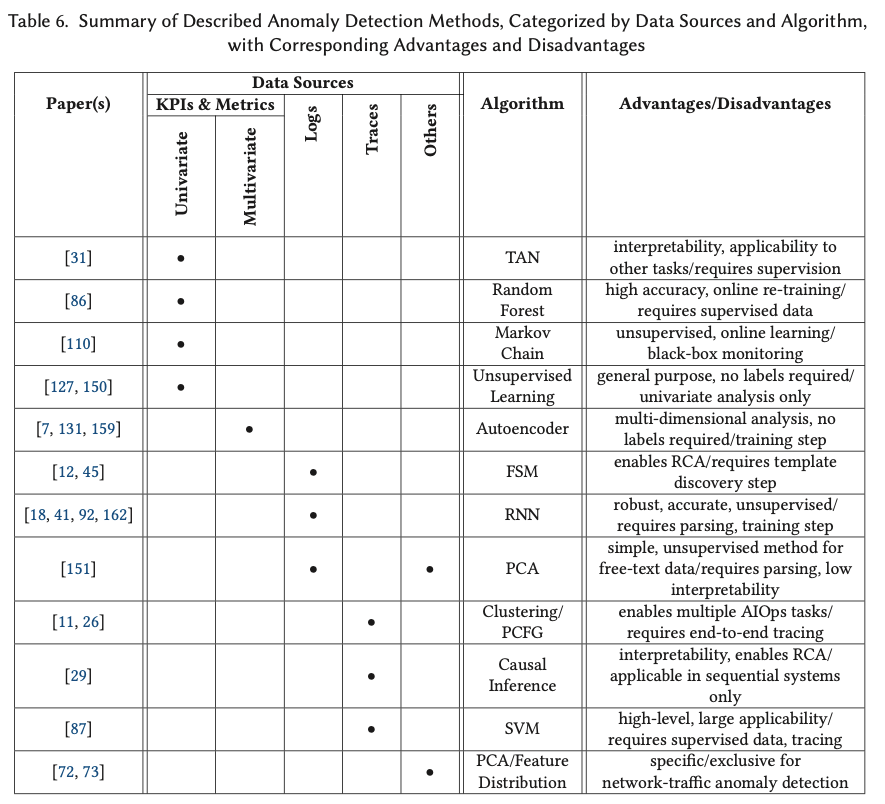
Internet Traffic Classification (ITC).
A task connected to network failure detection is Internet Traffic Classification (ITC).
ITC allows categorizing packets exchanged by a network system to identify network problems, to optimize resource provisioning and improve Quality-of- Service [43, 97].
Log Enhancement.
Another task connected to failure detection is log enhancement.
Its goal is to improve the quality and expressiveness of system logs, which are frequently used for detection and diagnosis tasks by IT operators and AIOps algorithms.
將是否要放置logging snippets轉換成一個二元分類問題,基於資訊增益的決策樹
Zhu et al. [168] propose a logging suggestion tool, called LogAdvisor, to learn practical logging suggestions from existing log instances.
In code snippets, several structural, syntactical, and textual features are extracted and filtered based on information gain, from which a decision tree is later trained to suggest logging of snippets as a binary classification problem.
通過資訊entropy來自動打紀錄檔,選擇紀錄檔級別,提升紀錄檔效率
In Reference [163], an approach for automated placement of log printing statements (Log20) based on information theory is proposed. First, entropy is shown to be an informative measure for the placement of printing statements. Then, a greedy dynamic programming algorithm for placing printing statements is implemented.
Root-cause Analysis (RCA)
Failure detection is the process of collection of symptoms(症狀), i.e., observations that are indicative of failures.
Root-cause analysis is, instead, the process of inferring the set of faults that generated a given set of symptoms [130].

Fault Localization.
Fault localization is about identifying the set of components (devices, network links, hosts, software modules, etc.) interested by a fault that caused a specific failure.
基於指標組合關聯關係的異常變化來定位
Several approaches [80, 83, 132] address fault localization by correlating abnormal changes in KPI values to particular combinations of attributes (representing, e.g., geographical regions, ISPs, hosts, buckets, etc.).
Hotspot [132] applies Monte Carlo Tree Search and hierarchical pruning to efficiently examine attribute combinations and measure how they relate to sudden changes in the Page View metric.
With Sherlock [9], Bahl et al. localize sources of performance problems in enterprise networks by constructing probabilistic inference graphs from the observation of packets exchanged in the network infrastructure.
Software Fault Localization (SFL) is fault localization in software components through source code analysis.
An SFL system typically returns a report containing a list of suspicious statements or components.
Zeller et al. [156] propose Delta Debugging, an algorithm for the determination of state variables causing a change in the outcome of execution runs.
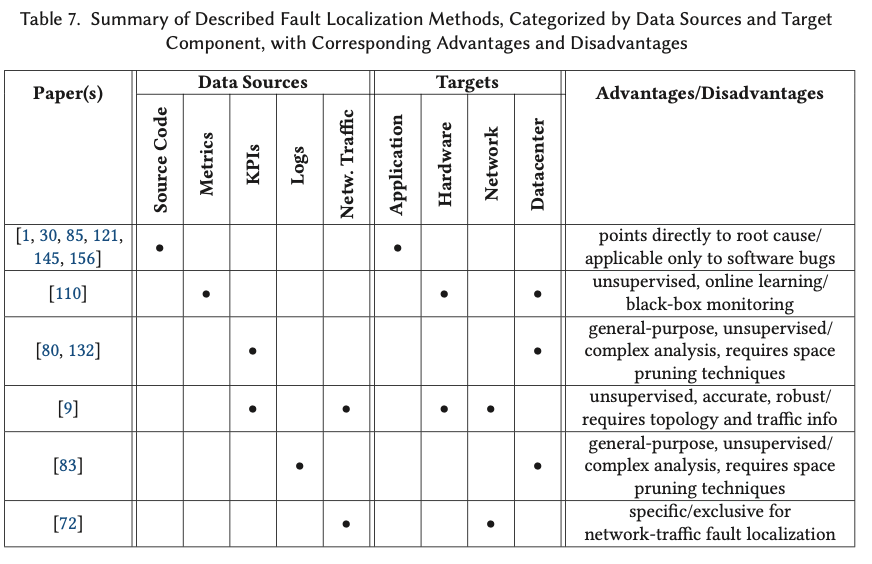
Root-cause Diagnosis.
Root-cause diagnosis identifies the causes of behavior leading to failures, by recognizing the primary form of fault.
For this reason, it is typically treated as a classification problem.
Due to the inherent complexity and inter-dependency between components in software systems, it is considered a challenging task [6].
Kandula et al. [64] develop Shrink, a failure diagnosis tool designed for optical links in IP networks, but certainly extendable to other networking scenarios (the authors mention, for example, the diagnosis of routers and servers).
SherLog [154] performs post-mortem analysis of logs and source code to diagnose software faults (such as code bugs and configuration errors).
Samir et al. [124] utilize Hierarchical Hidden Markov Models (HHMM) to associate resource anomalies to root causes in clustered resource environments, on the different levels of container, node, and cluster.
Other Tools Supporting RCA.
Aguilera et al. [3] describe several approaches to identify performance problems in distributed systems by analyzing causal path dependencies between black-box components.
Podgurski et al. [120] propose to use Machine Learning algorithms to classify and group soft- ware failures to facilitate error prioritization and diagnosis.
Remediation

Incident Triage.
Incident triage(事件分流) is the step in problem resolution dealing with categorizing a reported problem.
The purpose of triage is often the assignment to the correct expert resolution group [126, 158].
Solution Recommendation.
The approaches here described provide implementations for recommending solutions to occurring problems.
Most solutions are based on past incident history and rely on the annotation of solutions in a previous resolution window.
Zhou et al. [166] propose similarity-based algorithms to suggest the resolution of repeating problems from incident tickets.
The basic approach consists in retrieving k ticket resolution suggestions using a k-NN approach.
Wang et al. [140] propose a cognitive framework based on the use of ontologies to construct domain-specific knowledge and suggest recovery actions for tickets in IT service management.
Recovery.
We define as recovery approaches those methods taking direct and independent actions toward the resolution of a diagnosed problem.
CONCLUSION
